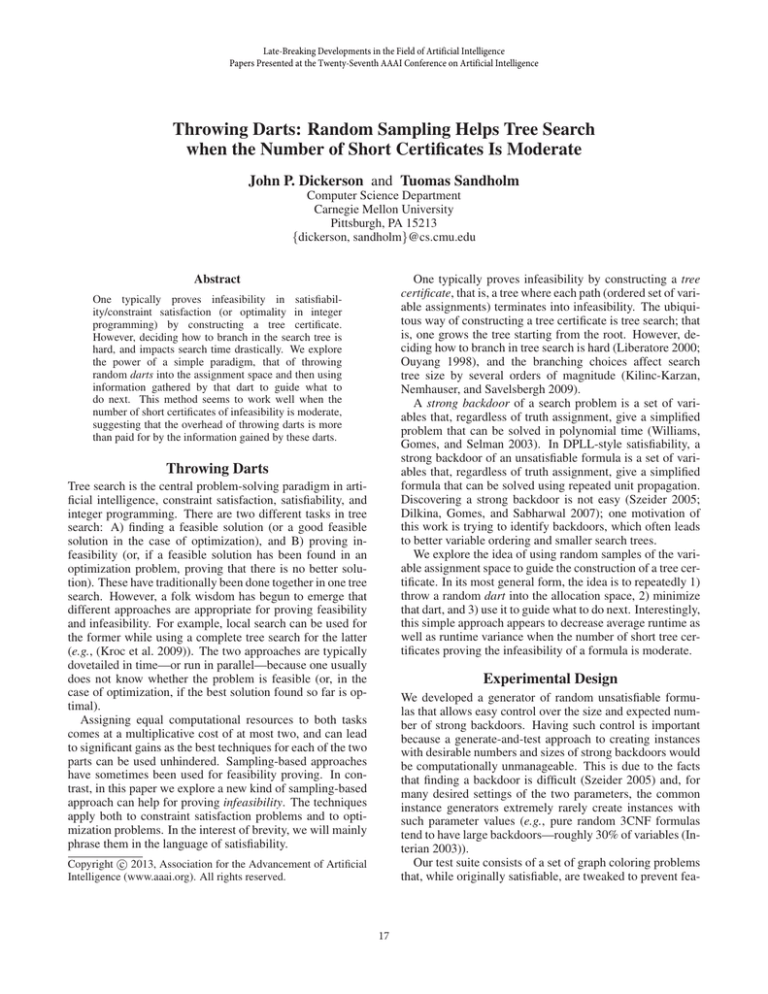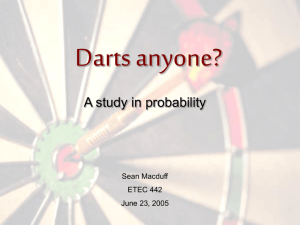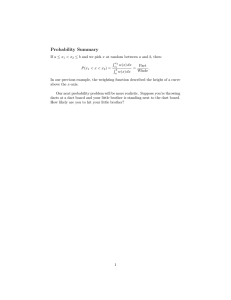
Late-Breaking Developments in the Field of Artificial Intelligence
Papers Presented at the Twenty-Seventh AAAI Conference on Artificial Intelligence
Throwing Darts: Random Sampling Helps Tree Search
when the Number of Short Certificates Is Moderate
John P. Dickerson and Tuomas Sandholm
Computer Science Department
Carnegie Mellon University
Pittsburgh, PA 15213
{dickerson, sandholm}@cs.cmu.edu
One typically proves infeasibility by constructing a tree
certificate, that is, a tree where each path (ordered set of variable assignments) terminates into infeasibility. The ubiquitous way of constructing a tree certificate is tree search; that
is, one grows the tree starting from the root. However, deciding how to branch in tree search is hard (Liberatore 2000;
Ouyang 1998), and the branching choices affect search
tree size by several orders of magnitude (Kilinc-Karzan,
Nemhauser, and Savelsbergh 2009).
A strong backdoor of a search problem is a set of variables that, regardless of truth assignment, give a simplified
problem that can be solved in polynomial time (Williams,
Gomes, and Selman 2003). In DPLL-style satisfiability, a
strong backdoor of an unsatisfiable formula is a set of variables that, regardless of truth assignment, give a simplified
formula that can be solved using repeated unit propagation.
Discovering a strong backdoor is not easy (Szeider 2005;
Dilkina, Gomes, and Sabharwal 2007); one motivation of
this work is trying to identify backdoors, which often leads
to better variable ordering and smaller search trees.
We explore the idea of using random samples of the variable assignment space to guide the construction of a tree certificate. In its most general form, the idea is to repeatedly 1)
throw a random dart into the allocation space, 2) minimize
that dart, and 3) use it to guide what to do next. Interestingly,
this simple approach appears to decrease average runtime as
well as runtime variance when the number of short tree certificates proving the infeasibility of a formula is moderate.
Abstract
One typically proves infeasibility in satisfiability/constraint satisfaction (or optimality in integer
programming) by constructing a tree certificate.
However, deciding how to branch in the search tree is
hard, and impacts search time drastically. We explore
the power of a simple paradigm, that of throwing
random darts into the assignment space and then using
information gathered by that dart to guide what to
do next. This method seems to work well when the
number of short certificates of infeasibility is moderate,
suggesting that the overhead of throwing darts is more
than paid for by the information gained by these darts.
Throwing Darts
Tree search is the central problem-solving paradigm in artificial intelligence, constraint satisfaction, satisfiability, and
integer programming. There are two different tasks in tree
search: A) finding a feasible solution (or a good feasible
solution in the case of optimization), and B) proving infeasibility (or, if a feasible solution has been found in an
optimization problem, proving that there is no better solution). These have traditionally been done together in one tree
search. However, a folk wisdom has begun to emerge that
different approaches are appropriate for proving feasibility
and infeasibility. For example, local search can be used for
the former while using a complete tree search for the latter
(e.g., (Kroc et al. 2009)). The two approaches are typically
dovetailed in time—or run in parallel—because one usually
does not know whether the problem is feasible (or, in the
case of optimization, if the best solution found so far is optimal).
Assigning equal computational resources to both tasks
comes at a multiplicative cost of at most two, and can lead
to significant gains as the best techniques for each of the two
parts can be used unhindered. Sampling-based approaches
have sometimes been used for feasibility proving. In contrast, in this paper we explore a new kind of sampling-based
approach can help for proving infeasibility. The techniques
apply both to constraint satisfaction problems and to optimization problems. In the interest of brevity, we will mainly
phrase them in the language of satisfiability.
Experimental Design
We developed a generator of random unsatisfiable formulas that allows easy control over the size and expected number of strong backdoors. Having such control is important
because a generate-and-test approach to creating instances
with desirable numbers and sizes of strong backdoors would
be computationally unmanageable. This is due to the facts
that finding a backdoor is difficult (Szeider 2005) and, for
many desired settings of the two parameters, the common
instance generators extremely rarely create instances with
such parameter values (e.g., pure random 3CNF formulas
tend to have large backdoors—roughly 30% of variables (Interian 2003)).
Our test suite consists of a set of graph coloring problems
that, while originally satisfiable, are tweaked to prevent fea-
c 2013, Association for the Advancement of Artificial
Copyright Intelligence (www.aaai.org). All rights reserved.
17
Figure 1: Median relative speed of increasing numbers of darts (bottom axis) in each of {86, . . . , 95} cliques (top axis).
number of cliques added. For every parameter setting, 20
instances were generated, and on each of them, 20 independent runs of the algorithm were conducted.
We compare the solution times for a darts-based strategy against that of pure MiniSat. We witnessed significant
speedup from darts in the “middle ground” of 80–95 cliques.
We hypothesize that when there are few short certificates
available, throwing darts will often result in such certificates
being missed. Conversely, when short certificates are ubiquitous (e.g., coloring a complete graph), DPLL is likely to
find a certificate quickly, so darts provide little benefit.
Figure 1 shows the relative speedups across 10 different
experimental settings in this promising range. Values above
1 represent a performance improvement over MiniSat without darts. Regardless of number of cliques, throwing just
250 darts provides, in terms of both mean and median, a
clear decrease in runtime. Runtime monotonically decreases
as we add more darts until between 5000 and 7500 darts. After that, the overhead of adding new clauses to the original
propositional formula (and the time spent on throwing and
minimizing the darts themselves) outweighs the benefit of
any information provided by the darts.
Furthermore, speed improvements from darts tend to correlate with large decreases in variance in runtime. Our
largest runtime improvements occurred at 2500–7500 darts;
in that region the variance was reduced by over an order of
magnitude. This suggests that throwing just a few thousand
darts—with low computational overhead—seems to cut off
the heavy tail of the runtime distribution, at least on these instances, better than MiniSat’s tree search, which itself uses
random restarts.
sibility. Our generator is a generalized version of that introduced in (Zawadzki and Sandholm 2010). We first ensure
that a randomly generated connected graph G = (V, E)
is k-colorable. This is done via the canonical transformation of a graph coloring instance into a SAT instance (see,
e.g., (Van Gelder 2008)), followed by a satisfiability check.
Unsatisfiable instances are discarded so they do not interfere with our control of the size and number of backdoors
discussed next. Then, a number n of (k + 1)-cliques are introduced into the graph, with n proportional to the desired
number of short certificates. While not significantly changing the structure of the graph, no (k + 1)-clique can be kcolored and thus this augmented graph cannot be k-colored.
So, the SAT formula is unsatisfiable.
A SAT solver can conclude infeasibility of such formulas
by reasoning only about the variables pertaining to a single
k + 1 vertex clique. In this way, we can control the size (k)
of a short certificate in the propositional formula as well as
the estimated number (n) of short certificates.1
We use the underlying solver (MiniSat (Eén and
Sörensson 2004) in the case of our experiments) to guide the
construction of each dart. Each dart is in effect one search
path from the root to a node where infeasibility of the path
can be detected. The path then constitutes a conflict clause.
For the construction of the path, we use uniform random
variable ordering. (This is only for darts throwing. For the
tree search that follows the dart throwing phase, we let MiniSat use its own variable ordering heuristics.) However, we
do employ repeated unit propagation using all the clauses in
the formula, both original and prior minimized darts.
Results
Conclusions
We varied both the cardinality of the formula’s set of short
tree certificates of infeasibility (i.e., number of cliques in the
graph) and the number of darts thrown. We performed experiments on these random, unsatisfiable graphs with |V | =
100 and |E| = 1000, with the number of colors k = 10.
Translating the augmented unsatisfiable coloring problem to
propositional logic yielded CNF formulas with 900 variables
and between 12000 and 35000 clauses, depending on the
These experiments suggest that a simple dart throwing strategy provides legitimate benefit, both in terms of runtime and
variance in runtime, on formulas with a “medium” number
of short certificates. With too few short certificates, dart
throwing can unluckily miss all of them, thus providing little
new information to the subsequent DPLL search. With too
many certificates, dart throwing provides redundant information to the tree search, resulting in little speedup. However, on instances in between these extremes, throwing even
a few hundred darts—at almost no computational cost—can
often result in both a significant runtime boost and a significant decrease in runtime variance. Successful dart throwing
1
The number of short certificates will not necessarily be exactly
n: two randomly placed cliques can overlap in such a way as to
create more than two cliques of the same size, given existing edges
in the graph G. For large enough V and relatively low numbers of
short certificates, we expect this to be rare and inconsequential.
18
adds enough information to alleviate the variance introduced
by the heavy tail of these runtime distributions.
References
Dilkina, B.; Gomes, C.; and Sabharwal, A. 2007. Tradeoffs in the complexity of backdoor detection. Principles and
Practice of Constraint Programming 256–270.
Eén, N., and Sörensson, N. 2004. An extensible SAT-solver.
In Theory and Applications of Satisfiability Testing, 333–
336. Springer.
Interian, Y. 2003. Backdoor sets for random 3-SAT. Theory
and Applications of Satisfiability Testing 231–238.
Kilinc-Karzan, F.; Nemhauser, G.; and Savelsbergh, M.
2009. Information-Based Branching Schemes for Binary
Linear Mixed Integer Problems. Mathematical Programming Computation 1(4):249–293.
Kroc, L.; Sabharwal, A.; Gomes, C.; and Selman, B. 2009.
Integrating systematic and local search paradigms: A new
strategy for MaxSAT. IJCAI.
Liberatore, P. 2000. On the complexity of choosing the
branching literal in DPLL. Artificial Intelligence 116(12):315–326.
Ouyang, M. 1998. How good are branching rules in DPLL?
Discrete Applied Mathematics 89(1-3):281–286.
Szeider, S. 2005. Backdoor sets for dll subsolvers. Journal
of Automated Reasoning 35:73–88.
Van Gelder, A. 2008. Another look at graph coloring via
propositional satisfiability. Discrete Applied Mathematics
156(2):230–243.
Williams, R.; Gomes, C.; and Selman, B. 2003. Backdoors
to typical case complexity. In International Joint Conference
on Artifical Intelligence, volume 18, 1173–1178.
Zawadzki, E., and Sandholm, T. 2010. Search tree restructuring. Technical Report CMU-CS-10-102, Carnegie Mellon University. Presented at the INFORMS Annual Conference, 2010.
19









